Electronics on the TA-04 TRF chassis
So far, my model is a chassis stuffed with TRF options all around and a mean looking bodyshell: I had to power it with a motor that would match these standards but remain within the limits of my driving skills (I auto-evaluate them around 23 turns. I confess it is pretty weak compared to what you can find on most racers, but I'm just a week-end driver: over 23 turns, I think that corners will be too lethal for my model health... thus for my bank account.
Tamiya offers a nice range of 23 turns motors:
- SuperStock BZ (reference 53930) for buggies
- SuperStock TZ (reference 53696) for on-road models on endurance and low speed tracks
- SuperStock RZ (reference 53697) for on-road models on sprint and high speed tracks
Superstock TZ and RZ motors have a major drawback for me: they wear brushes very fast. Even if brushes are quite cheap and can be easily changed, maintenance is still a constraint for a leisure use. The solution is to innovate and go for a modern brushless system: these motors don't have brushes (thus their name), they don't require maintenance, and their performance lasts in time because they (almost) don't wear at all. Tamiya offers several brushless combos:
Volac Brushless ESC BL2
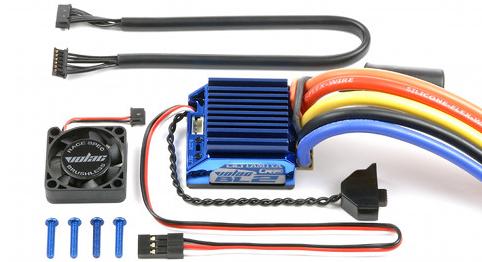
Transpeed motors
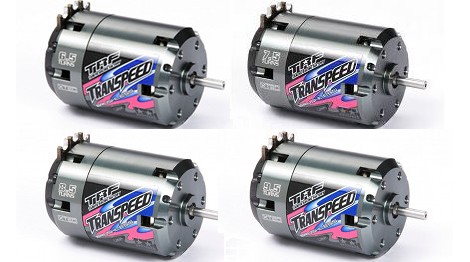
These TRF combos all feature a unique controller (reference 42144) that can pair with 4 different brushless motors (from 6.5T to 9.5T, references 42155 to 42158). This is the high-end range of Tamiya's offering, too expensive and too powerful for my driving skills. About power, the very basic rule to compare brushed and brushless motors is to consider a factor of 2. A 6.5T brushless motor is approximately the equivalent of a 13T brushed motor (considering they are both powered at 7.2v). This is a basic rule that gives a general idea, but it is not an absolute reference since:
- brushless motors generally deliver more torque than equivalent brushed motors
- technologies are very different: it's like comparing diesel and gasoline motors
- alike brushed motors, all brushless motors at a given announced power won't perform the same
- there are 2 different brushless motor design that deliver very different performances
Anyway, Tamiya's high-end offering is over both my budget and my driving skills. Fortunately, Tamiya has another offering:
Brushless ESC TBLE-01
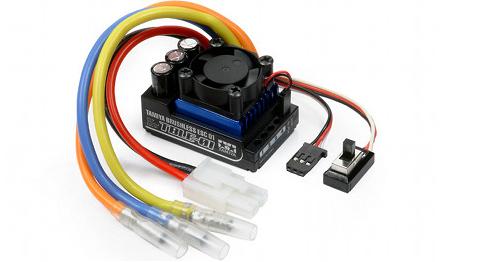
Brushless 01 motors
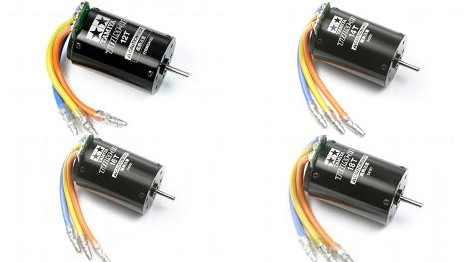
Here too, one unique controller (reference 45038) can be paired with 4 different brushless motors from 12T to 18T (references 54132, 54181, 54251 and 54252). The power delivered by the motors in this range are more "decent", as well as their prices ![]() : so I chose this controller that I will pair with the 12T motor to get performances close to the SuperStock RZ or TZ motors.
: so I chose this controller that I will pair with the 12T motor to get performances close to the SuperStock RZ or TZ motors.
The main problem on this chassis is where and how to fit the electronics and necessary cables. Usually, bathtub-shaped chassis are pretty easy to deal with (except my DF-03 Dark Impact). So far, I only knew about 4 wheel-drive shaft-driven transmissions, but for the first time, I have to deal with belts: this makes a big change. For memory, here's how the belts are located onto the chassis (highlighted in red):
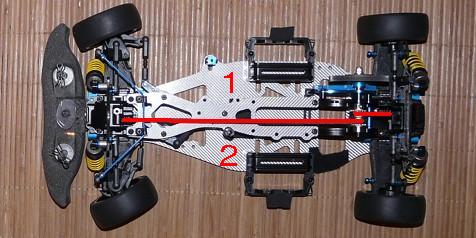
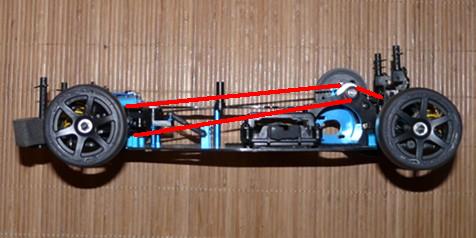
From above, the belts cross the chassis by the center, which is pretty normal and similar to shaft-driven transmission systems. However, the lateral view shows they slash-cross the chassis from a high starting point at the rear to a low ending point at the front: and this is where the problem is. It is much more complicated to pass cables from one side of the chassis to the other avoiding the belts in order to respect the manual suggested layout (the receiver pilled on top of the steering servo in 1 and the controller in 2). I couldn't think of any other possible layout than the one suggested in the manual.
After many attempts, I finally managed to set all this up, even if it is far from being a neat job:
Cables on controller and motor side
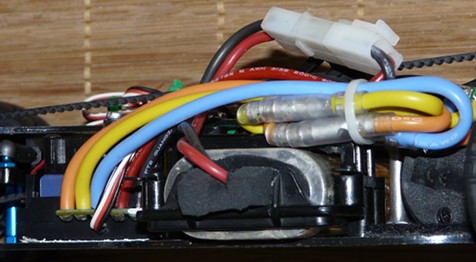
The rest of electronics on the chassis opposite side
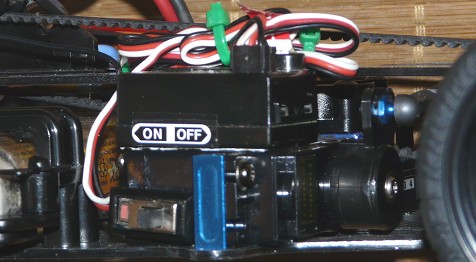
Cables linking the controller and the motor are pilled up and tied to the battery stay. Not very clean and that's when I do regret my lack of soldering skills since everything would have been much easier if I could have reduced cables length. Cables linking the controller and the receiver cross the chassis using the upper deck on which they are tied to. The receiver is double-sided tapped onto the steering servo and extra cable length is tied to the upper deck.
Installing the controller forced me to find a solution since the double-sided tape was not strong enough to correctly maintain it (and/or the sticking surface was too small). The belt is less than 1cm close behind it, so I had to find a way to better fix it. This controller is so compact that it doesn't leave any way to better fix it: you can choose between double-sided tape and... period. Well, not a strict period, may be suspension marks since I found a solution ![]() :
:
- replace one screw of the fan with a longer one in order to use a hole available on the upper deck
- add a spacer between the fan and the upper deck (this secures the fix)
I had my first solid fix and the double-sided tape would prevent the controller to rotate around this axle. But I felt I needed one more solid fix to be sure:
- again, I replaced another screw on the fan with a longer one and fixed a tie-rod
- I screwed the tie-rod to another hole available on the upper deck
Now the controller is securely fixed close to the belt that is located a few millimeters behind it. However, even if the controller entirely sits on the chassis lower deck, I preferred to add a protection against any side hit. I did with what I had: a damper stay, a brass tube and a rilsan collar. The other side of the brass tube is fitted against the battery stay. The damper stay is screwed to an unidentified part I had which is screwed to the chassis.
Controller secured fix
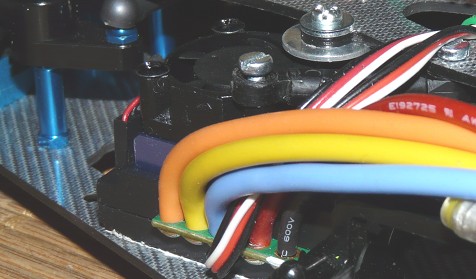
Protection guard for the controller
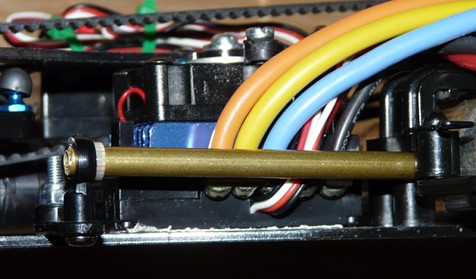
To all those of you who have doubts about the guard efficiency in case the chassis would suffer a severe side hit, let me tell you that you are right. But to reach the controller, it means the chassis lower deck and the battery pack wouldn't be enough: if so, the guard would never be strong enough to protect the controller. However, in case of such a hit, many other parts will probably be damaged before reaching the controller (the front wheel and arm). If this should happen, the controller destiny might be only one more damage on a so long list that the chassis would be wrecked. So this guard is mainly there for the driver's serenity and he hopes it is useless ![]() .
.
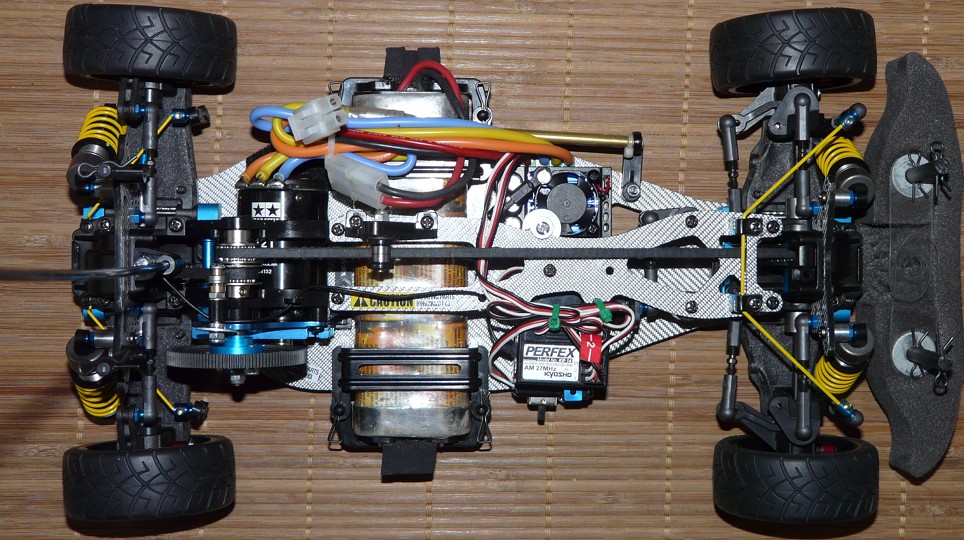
My chassis is now finished and ready to run. Tieing cables is tricky and I spent quite a time before I found how to make them cross from one side to the other keeping them out of reach of the belts.
First run
A shy sun ray found its way through the clouds so I took the monster at the track for a first quick run. Due to track conditions, I unfortunately could only test it for a few laps. Nevertheless, this is a successful ending for this specific project in my collection: the bodyshell gives both a radical and unusual look to the car and the chassis is really fast. Despite of the few time spent driving it, the brushless motor is really powerful and has tons of torque at low speed, but I will be able to handle it with more practice and a better setup. The other surprise is silence: the motor is less noisy than a common brushed motor (even if the difference is not that important). Above all, the belt-driven transmission gives the impression that the car flies instead of producing a typical mechanical roar. To compare real car sounds, I would say that my Lancia Delta on the TA-01 chassis would sound diesel-powered when the Escudo would sound like an electric-powered car.
Both the visual and acoustic effects make the car feel like it were a fighter aircraft on the track. This is exactly what I wanted for this model ![]() .
.
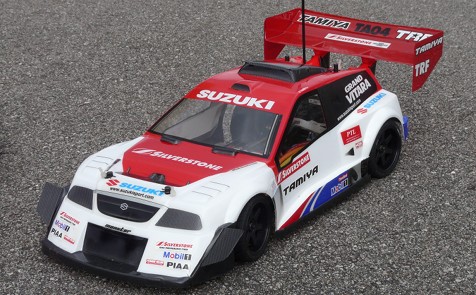
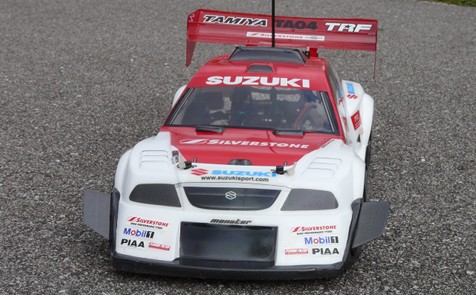
For the next run, I will need to find the correct settings in order to better handle the power. I will also try to take action pictures to capture the overall visual feeling with this model (in particular the one brought by the 3Racing brake discs) and to describe the front one-way unit effect on the chassis handling.
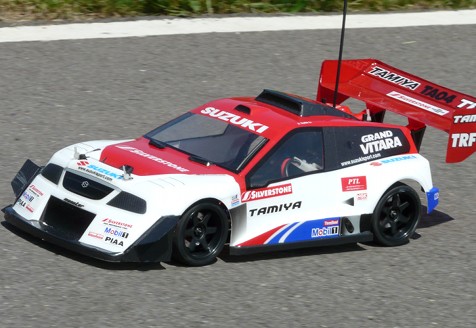
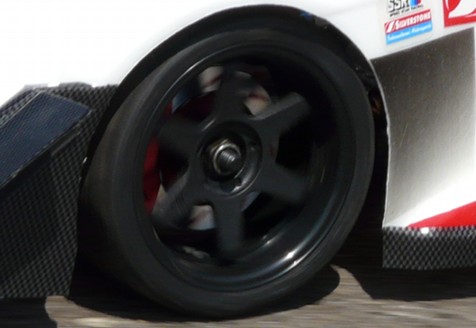
Unfortunately, I did not manage to better capture the brake discs: it is already delicate to capture models in action, so zooming on a wheel is even more tricky. Nevertheless, the visual effect from the side of the track is very realistic.
As for the front one-way unit, it heavily modifies the chassis handling in corners: because the front wheels no longer brakes, the rear drivetrain needs to do it all. But this implies the chassis becomes pretty unstable and prone to spin around. To avoid this, you need to anticipate the brake point, first by letting the motor brake operate and then by braking only to the minimum while the car is still in straight line. Braking at the corner entry will always lead to the same consequence: lost of grip at the rear and spin-around. When braking and corner entry went well, then the car can re-accelerate much sooner than usual because the front one-way unit provides much better front drivetrain traction. So entering the corner is slower than usual, but you can push throttle much sooner because the chassis is like on a rail in the corner.
In concrete, I don't have the driving skills to really benefit from the front one-way unit: I mostly improved my spin-around technique ![]() . Anyway, I will leave it on in order to force me to improve my braking technique, especially to force me to brake only when the car is in straight line.
. Anyway, I will leave it on in order to force me to improve my braking technique, especially to force me to brake only when the car is in straight line.
Related article




